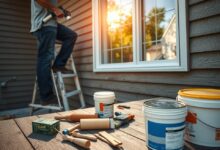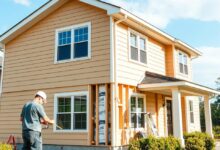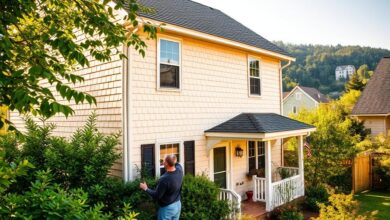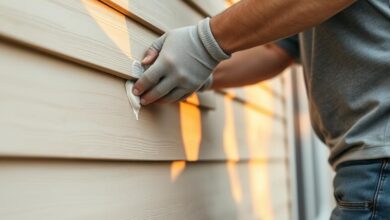Noise-Blocking Insulated Siding: Expert Product Review
Are you tired of the constant din of traffic or the chatter of neighbors disrupting your peace? Noise-blocking insulated siding is a game-changer for homeowners seeking a quieter living space. This innovative solution not only enhances your home’s exterior but also significantly reduces outside noise.
In this expert review, we’ll explore the world of insulated siding for noise reduction. We’ll look at its benefits and compare top products. Our goal is to help you make an informed decision when choosing the best noise-blocking insulated siding for your home.
Key Takeaways
- Understanding the technology behind noise-blocking insulated siding
- Benefits of using insulated siding for noise reduction
- Top products in the market for noise-blocking insulated siding
- Factors to consider when selecting the best insulated siding
- Installation tips for maximum noise reduction
Understanding Noise-Blocking Insulated Siding
Many people want a quieter home. That’s why they look into noise-blocking insulated siding. This siding is made to cut down on outside noise, making homes more comfortable.
What Makes Siding Noise-Reducing
Soundproof siding works by its design and materials. It has insulation that blocks sound. The STC ratings of siding materials show how well they reduce noise.
Benefits Beyond Noise Reduction
Noise reduction siding does more than just block noise. It also saves energy and lasts longer. It adds insulation, which keeps homes warmer in winter and cooler in summer.
This makes insulated siding a great choice for anyone wanting to improve their home. It’s not just about quieting down the noise.
How Insulated Siding for Noise Reduction Works
Insulated siding helps block outside noise by its design and materials. It acts as a sound barrier. Its success depends on several important factors.
The Science of Sound Dampening
Sound dampening means a material or system can lessen sound wave transmission. Insulated siding uses materials that soak up or spread out sound energy. The siding’s design, including insulation type and thickness, greatly affects its sound blocking.
STC Ratings Explained
The Sound Transmission Class (STC) rating shows how well a material or assembly blocks sound. A higher STC rating means better soundproofing. Insulated siding’s STC ratings can be from 20 to over 50, based on the product and how it’s installed.
Insulation Types and Their Effectiveness
Various insulation types in siding impact its noise reduction. Common ones are foam board, fiberglass, and reflective insulation. The insulation type and its thickness influence the siding’s STC rating.
| Insulation Type | STC Rating | Noise Reduction Effectiveness |
|---|---|---|
| Foam Board | 25-35 | Good |
| Fiberglass | 20-30 | Fair |
| Reflective Insulation | 15-25 | Poor |
Knowing about sound dampening, STC ratings, and insulation types helps homeowners choose the right insulated siding. This choice is key for reducing noise.
ProVia Insulated Vinyl Siding Review
ProVia Insulated Vinyl Siding is a great choice for a quieter home. It’s known for cutting down on outside noise. This makes it a popular pick for homeowners.
Overview
ProVia Insulated Vinyl Siding looks good and works well. It makes your home look better and also helps block out noise.
Key Specifications
- Insulated backing for noise reduction
- Durable vinyl construction
- Variety of styles and colors
Pros
The key benefits of ProVia Insulated Vinyl Siding include its effective noise reduction and durability. It’s also easy to keep up with.
Cons
Some people might think it costs too much at first. But, the long-term benefits are worth it.
Features
ProVia Insulated Vinyl Siding has many features. It has an insulated backing and is built to last.
Noise Reduction Performance
This product is great at reducing outside noise. It makes your home quieter and more peaceful.
Recommendations
If you want to cut down on outside noise, try ProVia Insulated Vinyl Siding. It’s a strong recommendation. It’s both functional and stylish, making it a smart choice.
James Hardie Insulated Fiber Cement Siding Review
James Hardie Insulated Fiber Cement Siding is a top pick for a quieter home. It reduces outside noise, is durable, and looks great.
Overview
James Hardie Insulated Fiber Cement Siding is a complete solution for homeowners. It combines fiber cement siding with advanced insulation.
Key Specifications
- Material: Fiber cement
- Insulation: Integrated foam insulation
- STC Rating: Up to 50
- Durability: Resistant to rot, fire, and pests
Pros
The James Hardie Insulated Fiber Cement Siding has many benefits. It reduces noise well and lasts long. It also stands up to the weather.
Cons
It’s worth noting that James Hardie Insulated Fiber Cement Siding costs more than regular siding. You’ll need a pro to install it.
Features
This siding has advanced insulation that cuts down noise and saves energy. Its fiber cement makes it last a long time.
Noise Reduction Performance
The fiber cement siding noise reduction is impressive. Its foam insulation gets an STC rating of up to 50. This makes it a strong noise barrier.
Recommendations
For a siding that’s both durable and quiet, choose James Hardie Insulated Fiber Cement Siding. It’s perfect for homes in loud areas or for those who want peace.
Mastic SolarDefense Insulated Siding Review
Homeowners seeking a siding that guards against weather and noise might find Mastic SolarDefense appealing. It’s known for its energy-saving and noise-cutting abilities.
Overview
Mastic SolarDefense Insulated Siding aims to enhance your home’s exterior and cut down on noise. It merges insulated siding with cutting-edge tech for better noise control.
Key Specifications
- Insulation Type: Foam-backed
- STC Rating: Up to 27
- Material: Vinyl siding with foam insulation
Pros
- Effective noise reduction
- Energy efficiency
- Durable and weather-resistant
Cons
- Higher upfront cost
- Limited color options
Noise Reduction Performance
Mastic SolarDefense excels in cutting down external noise. Its foam-backed insulation and high STC rating make it stand out.
Recommendations
For those valuing energy savings and noise reduction, Mastic SolarDefense is worth considering. Yet, the higher initial cost is a factor to consider.
Comparison of Top Insulated Siding for Noise Reduction
More people want quiet homes, so comparing insulated siding for noise reduction is key. Homeowners look for ways to block out outside noise. Insulated siding is a good choice for this.
Noise Reduction Effectiveness
Homeowners care a lot about how well insulated siding blocks noise. Different materials block noise differently. For example, ProVia Insulated Vinyl Siding has high Sound Transmission Class (STC) ratings. This means it blocks noise very well.

Durability and Weather Resistance
Durability and weather resistance are also important. James Hardie Insulated Fiber Cement Siding is strong against bad weather. It can handle very hot or cold temperatures.
Energy Efficiency Comparison
Insulated siding also saves energy. Looking at energy savings, Mastic SolarDefense Insulated Siding leads. It uses advanced insulation to save a lot of energy.
| Brand | Noise Reduction Effectiveness | Energy Efficiency |
|---|---|---|
| ProVia Insulated Vinyl Siding | High | Good |
| James Hardie Insulated Fiber Cement Siding | Medium | Excellent |
| Mastic SolarDefense Insulated Siding | High | Excellent |
Aesthetic Options and Customization
Looks matter too. All three brands have many styles and colors. Homeowners can pick what they like and what fits their home’s design.
Best Value for Different Budgets
Cost is also a big deal. ProVia and Mastic SolarDefense are priced well. But James Hardie is pricier. Yet, its long-lasting quality and low upkeep make it worth it in the long run.
Installation Considerations for Maximum Noise Blocking
To block noise effectively, insulated siding needs careful installation. The siding’s performance in reducing noise depends on how well it’s put in place.
Professional vs. DIY Installation
Homeowners often wonder if to hire a pro or do it themselves. DIY saves money but needs a lot of skill and time. A pro ensures the siding works best at blocking noise.
“A pro can really make a difference,” says a contractor. “They know how to do the job right.”
Proper Installation Techniques
Right installation is key for noise reduction. This means the siding is tight, seams are sealed, and insulation is spread out right.
- Securely fasten the siding to the wall studs.
- Seal all seams and joints to prevent air leaks.
- Ensure even distribution of insulation for consistent noise reduction.
Common Installation Mistakes to Avoid
Some mistakes can hurt the siding’s noise-blocking power. These include bad sealing, uneven insulation, and wrong fastening.
Additional Soundproofing Measures
More steps can boost noise reduction. Adding mass to walls, soundproofing windows and doors, and sealing gaps help a lot.
By focusing on these installation tips and adding more soundproofing, homeowners can get the most out of their insulated siding.
Conclusion
Choosing the right insulated siding can make your home quieter and more comfortable. This article looked at different types, like ProVia Insulated Vinyl Siding and James Hardie Insulated Fiber Cement Siding. We also talked about Mastic SolarDefense Insulated Siding.
These options not only cut down on noise but also last long, save energy, and look good. Knowing how sound works and what STC ratings mean helps you pick the right siding.
In short, insulated siding is a smart choice for those wanting a quieter home. Think about how well it blocks noise, how long it lasts, and how it saves energy. This way, you can pick the best siding for your home and enjoy peace and quiet.








